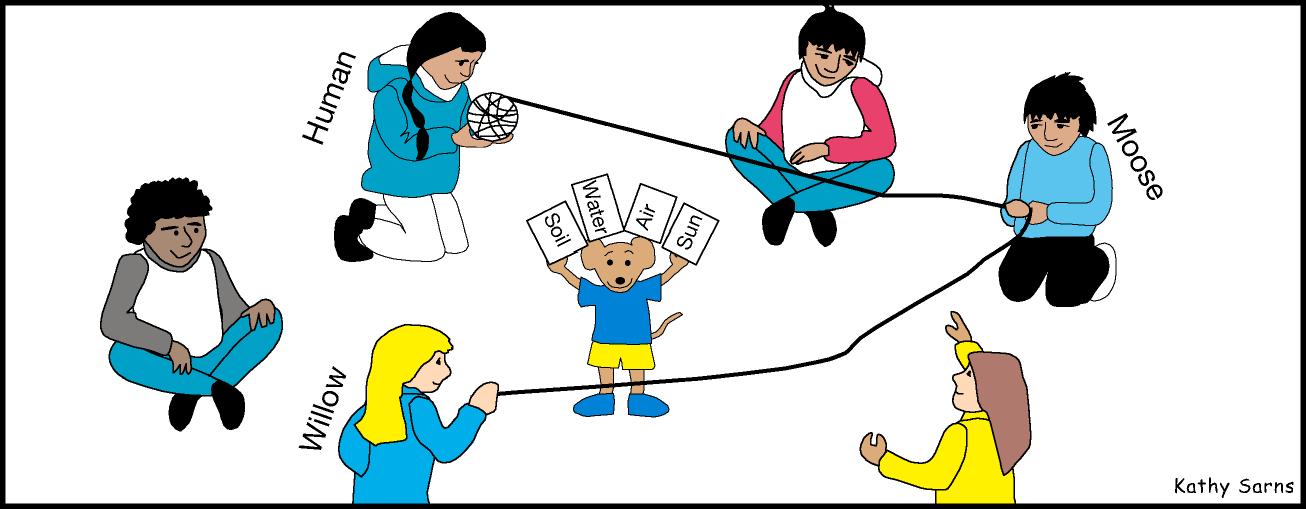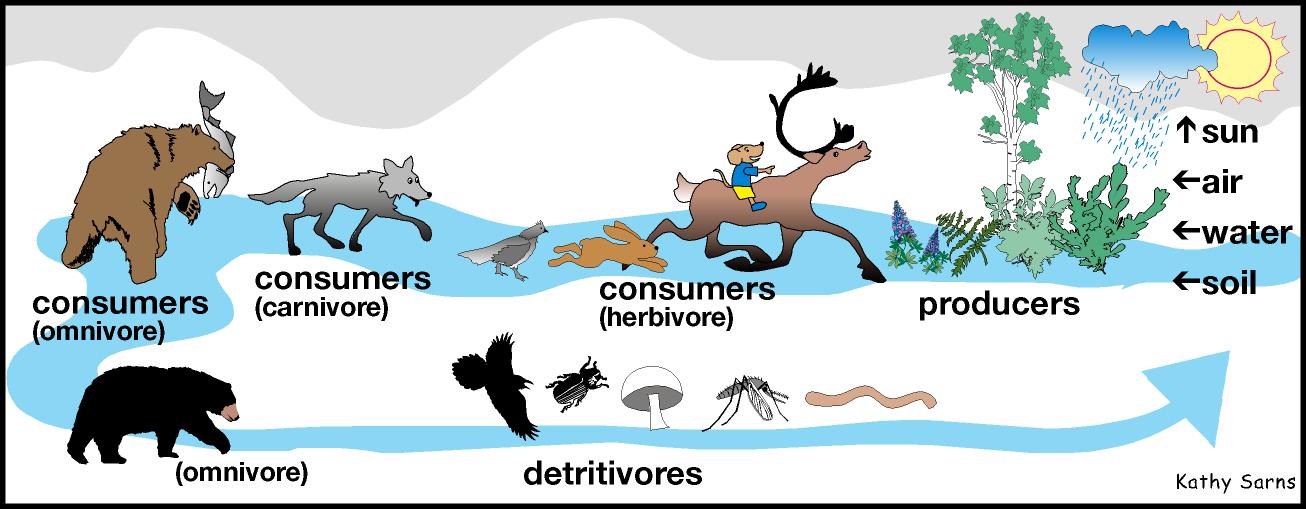
|
 |

| Grade Level: 5-12 |
| Alaska State Content Standards: SA14, SA15 |
| Subject: Science |
| Skills: Classifying, Predicting |
| Duration: 45 minutes |
| Group Size: whole group |
| Setting: indoors |
| Vocabulary: food chain, food web, producer, consumer, herbivores, carnivores, omnivores, detritivores |
OBJECTIVE
Students will be able to form boreal forest and tundra food chains.
TEACHING STRATEGY
Students will participate in an active game to form food chains of the boreal forest.
MATERIALS
![]() Alaska Ecology Cards (see Advanced Preparation)
Alaska Ecology Cards (see Advanced Preparation)
String
Tape
TEACHER BACKGROUND
A food chain describes the path of energy and nutrients from the non-living environment, through the living environment, and back to the non-living environment.
At the base of the food chain are the building blocks of the ecosystem: air, water, soil, and energy from the sun Plants that use these building blocks to grow and to make their own food are called producers. Producers in the boreal forest and tundra include plants, lichens, algae, and some bacteria.
All organisms other than producers are called consumersbecause they obtain energy and nutrients by eating, or consuming, other living things There are four major groups of consumers: herbivores, carnivores, omnivores, and detritivores. Animals that eat plants are called herbivores Willows (producers) are eaten by snowshoe hares (herbivores). Animals that eat meat are called carnivores.An herbivore can be prey for a carnivore. For example, a snowshoe hare (herbivore) may be eaten by a lynx (carnivore) Animals that have few or no predators are consumers found at the top of the food chain. Omnivoreseat both plants and animals. Bears are a good example of an omnivore, feeding on mammals, berries, and fish.
There is no "waste" in nature. Every plant or animal that dies is decomposed and returned to the soil Detritivores are consumers that eat dead organisms and waste material. They break down, or decompose, dead plant and animal material, returning the nutrients to the soil where they are available again for plant growth. Without detritivores, producers would soon run out of the minerals and nutrients that they need to make their food. Detritivores include some large animals, such as ravens; however, the most important detritivores are invertebrates (such as insects), fungi (such as mushrooms), and microscopic organisms (such as bacteria).
All plants and animals are part of at least one food chain and often more than one. Many interconnecting food chains form a food web. When forces such as fire, flood, insect outbreak, or human activities cause changes to the plants, animals, or non-living components of the ecosystem, the entire food chain is affected As a result, plant or animal populations may increase or decrease depending on where the population is in the food chain It is important to learn about the food chains of the boreal forest and tundra so that we can understand how changes to the environment affect forest and tundra populations.

ADVANCED PREPARATION
- Make 4 large cards, each one reading: water, sun, soil, air.
- Select the Boreal Forest or Tundra Alaska Ecology Cardsfrom the list below, starting at the top of the list and moving downward; have one card for each student in the class. Be sure that you include the habitat and food information provided on the cards. You may wish to laminate the cards for future use (Ecosystem/Unit 2).
BOREAL FOREST
Foliose
Lichens
Caribou
Brown Bear
Marten
Red Fox
Voles
Club Mosses
Springtails
Molds, Mildews, and Rusts
Ground Beetles
Common Raven
Small Thrushes
Merlins
Segmented
Worms
Low Bush
Cranberry
Pine Grosbeak
Sharp-shinned
Hawk
Fireweed
Snowshoe Hare
Lynx
Great Gray Owl
Aspen
Moose
Wolf
White Spruce
Porcupines
Cottongrass
Soapberry
Willow
Aphids
Spiders
Redpolls
Bot and Warble Flies
Humans
Blueberry
Wild Rose
Raspberry
Balsam Poplar
TUNDRA
Foliose
Lichens
Caribou
Brown Bear
Club Mosses
Heather
Springtails
Ground Beetles
Mosquitoes
Northern
Shrike
Common Raven
Short-eared
Owl
Lowbush
Cranberry
Ptarmigan
Red Fox
Bog Blueberry
Lapland
Longspur
Weasel
Willow
Tundra Hare
Wolf
Grasses
Lemming
Rough-legged
Hawk
Loon
Goose
Vole
Sedges
Musk Ox
Humans
Cottongrass
Bot and Warble Flies
Geese
Dall Sheep
Moss Campion
Arctic Ground
Squirrel
Labrador Tea
PROCEDURE
- On the board write a list of the cards you are using. Discuss the concept of a food chain and give one or two examples using some of the animals and plants listed on the board. Show how two predators may share the same prey, causing branching of the food chains to form a food web.
- Give each student a card and some tape Students read about their plant or animal noting in particular its foods and its predators Students tape their card face up on the front of their clothes.
- Have the group sit in a circle In the center of the circle place the cards for air, water, soil, and sun. Give the ball of string to a student who has a plant card. The student then passes the string to an organism in the circle with which that animal interacts. This process goes on around the circle until all the organisms are linked together by the string. Finally the ball is returned to the first student.
- The students now increase the size of the circle until the string is taut. The teacher tugs on one part of the string When each student feels a tug, they tug gently on the string. This should cause the entire circle to vibrate from end to end. Ask the students to explain how this vibration would be felt in an ecosystem.
- Have one of the students drop out of the circle. Find out how many other students must, then also, drop out because of their dependence on that organism How would this affect the rest of the ecosystem circle? After a discussion about food chains and food webs, discuss the nonliving factors upon which everything depends.
- As the class continues to hold their string, have them imagine that a fire burns through the area Which animal populations would be affected? These animal populations will decline and be unable to support their predator populations Their predators will have to find alternate prey to feed on. Can these predators find other prey in the food web or will they have to move to another area in search of food? How long will it take for predator and prey populations to recover in the area? Two important factors determine when a burn site can support wildlife: 1. How severe the fire was that burned the area, and 2. If there are unburned areas left in the burn site.
EVALUATION
Have each student draw a new food chain, and food web, using other Alaska Ecology Cards.
REFERENCES
Adapted with permission from Teacher’s Guide – Fire in the Boreal Forest and Tundra of
Alaska, US Fish and Wildlife Service, Susan Quinlan, 1991.
| Printable version | Add to favorites | Make Alaska FWS my homepage |
| Site designed and maintained jointly by the USFWS Alaska Region Division of Information Resource Management (IRM) and External Affairs (EA). |